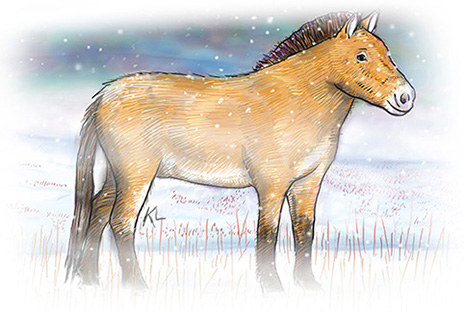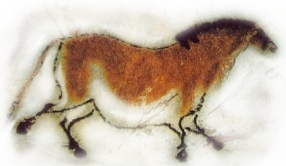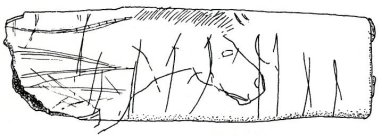
Happy Winter Solistice!
My painting is a reconstruction of what a horse looked like during the time of the Ice Age based on cave paintings. Representations of horses and other animals were carved, painted and drawn by Upper Palaeolithic artists and grace the walls of several European caves. The most famous examples are found in Lascaux and Chauvet in France and Altimera in Spain.

Cave painting of a horse from Lascaux
This equine image from Lascaux (dating approximately 17,000 years ago) reveals features similar to the Jungarian horse or Przewalski’s horse, which is known as the takhi in Mongolia. It is dun coloured with a big white belly and has a dark brown mane. Other cave paintings also feature horses in their winter coats with long hair around the jaw and hoofs. The frozen body of a Pleistocene stallion known as the Selerikan horse was found in Siberian permafrost in 1968 and its preserved hide confirms the accuracy of the Upper Palaeolithic paintings.

The ‘Ochre Horse’ (source: British Museum)
Horse bones have been found in Britain at sites such as the Pin Hole Cave, Creswell Crags, Derbyshire (dating around 50,000 to 45,000 BCE) and Kent’s Cavern, Devon. So far there is not much evidence with regards to art from the Upper Palaeolithic in the UK, let alone equine depictions. A bone with an engraving of a horse’s head, however, was found in Robin Hood Cave in the Creswell Crags. It was originally known as the ‘Ochre Horse’ (dating approx. 13,000 to 11,000 years old) and now resides in the British Museum collections. At the moment, the Ochre Horse is the only piece of Upper Palaeolithic portable art with an animal depiction found in Britain.